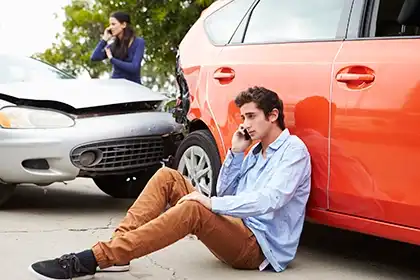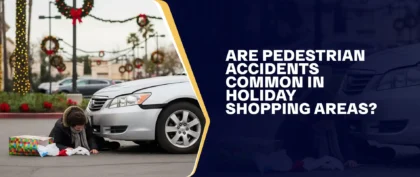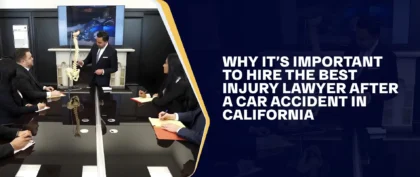Table of Contents
It’s natural for parents to worry about their children’s safety once they start driving. They strive to instill wise decision-making behind the wheel by teaching them the rules of the road and promoting responsible behavior. However, many risk factors go unrecognized and contribute significantly to the high rate of teen car crashes.
The California Highway Patrol (CHP) has recognized the need to manage the leading causes of severe injuries and fatalities from road crashes affecting adolescents. As such, they created the Teen Distracted Drivers (TDD) Grant in 2010 to promote community traffic safety, education, and preventive initiatives. Since then, authorities have amplified their initiatives in enforcement, public awareness, educational efforts, and social media advocacy for safe teen driving.
Main Causes Of Teen Car Accidents
Certain habits or behaviors contribute to the increasing number of car accidents, resulting in injuries and fatalities among teenage drivers and passengers.
Here are the common reasons why teen vehicle accidents keep happening in the United States:
Driving With Insufficient Experience
Amateur drivers are three times more likely to be injured in traffic accidents than older drivers due to factors like:
- Overestimating their skills.
- Failing to identify potential risks on the road, such as wet pavements or braking vehicles.
- Lacking practical experience in navigating heavy traffic and adverse weather conditions effectively.
The likelihood of an accident increases as soon as they obtain a driver’s license. It declines as they receive more experience. In particular, the first months after obtaining a driver’s license are associated with an increased risk of car accidents. Many teens may overestimate their driving skills despite having insufficient experience, which often results in poor decision-making on the road.
Inexperience is a major contributing factor to teen car accidents. Young drivers may not have fully developed judgment skills, which can make it difficult for them to respond effectively to sudden changes in road conditions. Additionally, they are typically less familiar with complex driving situations and may not react appropriately in unexpected circumstances.
Distracted Driving
The CDC also stated that the majority of distracted driving-related deaths in the U.S. occur among drivers under the age of 20. The most common cause is texting or emailing while driving or operating a vehicle. Checking social media, filming content, and video-calling friends while driving can divert the teens’ attention away from the road, increasing the risk of motor vehicle accidents.
Speeding
Teens who engage in behaviors, such as speeding and racing, are more prone to accidents. Male teen drivers are more likely to take such risks, especially when accompanied by other male passengers.
Inexperience may also play a role, as they might fail to adjust their speeds according to the road conditions. For instance, many new drivers fail to slow down when it’s raining or snowing, not accounting for their vehicles’ loss of traction on wet and slippery pavements.
Emotional Driving
Teenagers experiencing a wide range of intense emotions are more likely to drive while affected by their feelings, which can significantly impair their concentration and decision-making while driving. Emotional driving might include reacting to a heated argument, experiencing a breakup, or other common emotional stresses of teenage life. These emotional states can distract young drivers from focusing on the road and responding appropriately to traffic conditions and signals. Implementing strategies such as teaching coping mechanisms in driver’s education and encouraging open conversations about emotional health could reduce the risks associated with emotional driving.
Weekend And Night Driving
According to the Insurance Institute for Highway Safety (IIHS), teens driving at night run a very high risk of dying in collisions. The majority of teenage motor vehicle crash deaths in 2021 occurred over the weekend, especially between 9 PM and midnight. These fatalities can be attributed to the higher number of intoxicated drivers on the road. Overfatigue and limited vision might also significantly affect the driving abilities of inexperienced youths.
Overconfidence
Many teen drivers overestimate their driving abilities, a common trait among new drivers who have yet to encounter diverse and challenging road situations. This overconfidence can manifest as taking corners too quickly, braking too late, or overtaking in unsafe conditions. Such behaviors can lead to maneuvers beyond the driver’s capability to handle safely, particularly in challenging driving conditions such as wet or icy roads or heavy traffic. Enhanced driver education programs focusing on the limits of one’s skills and the dynamics of vehicles under various conditions can help mitigate this risky behavior.
Driving Under The Influence (DUI)
Teenagers who overestimate their limitations may decide to drive after taking alcohol or drugs. These substances can severely impair a person’s ability to operate a vehicle safely. The effects include blurred vision, altered depth perception, reduced reaction time, and uncoordinated movement.
Alcohol Use
Young drivers don’t usually consume alcohol as much as adults due to legal restrictions. However, when they do, the likelihood of an accident increases significantly. The IIHS report revealed a concerning trend among teenagers between the ages of 16 and 17. Around 19% of passenger vehicle drivers who were fatally injured had blood alcohol concentrations (BAC) of 0.08% or above.
Drug Use
Drugs can impair judgment and increase risk-taking tendencies, which are especially dangerous when driving. Note, however, that these substances don’t only include illicit drugs but also other legal medications. Some cold or allergy medicines, for example, can induce drowsiness or nausea. This DUI risk is something that parents should discuss with their teens even before they start driving.
Driving With Young Passengers
Driving with friends can be exciting for teenagers, but it can also be risky. Due to peer influence, the likelihood of a collision increases when a teen driver is riding with another teen or young adult. Teenagers may feel pressured to impress their friends and show off by driving recklessly and violating traffic laws, like running a red light.
Another risk factor is overcrowding. Exceeding the vehicle’s capacity can compromise the driver’s ability to control the car and put undue pressure on car parts like tires and brakes, leading to faster deterioration and auto defects.
Driving On Urban And Rural Roads
Urban and rural roads present unique challenges for teen drivers, and the risk of accidents increases if they don’t know how to handle them. Teen drivers must remain vigilant and adaptable in dynamic environments.
Here are some driving challenges that teen drivers may face on urban roads:
- Complicated Intersections and Interchanges: Many metropolitan intersections and interchanges have intricate designs with turn lanes, several signal phases, and occasionally inadequate signage. Teen drivers may become confused by this intricacy and miss turns, use the wrong lanes, or even get into accidents if they don’t handle the intersections correctly.
- Heavy Traffic Congestion: Inexperienced drivers may struggle to handle the often congested traffic in urban areas. A steady stream of automobiles, including cars, trucks, commercial vehicles, buses, and motorcycles, requires teen drivers to remain vigilant, control their vehicles, maintain a safe following distance, and be ready for unplanned stops.
- Narrow Streets With Parked Cars: Narrow streets with parked cars can be found in many cities, sometimes on one side or both. The road’s usable width is reduced, making it more difficult for teenage drivers to drive safely without sideswiping parked cars or mirrors. They must also watch for unexpected car doors opening and people getting out from between parked cars.
- Pedestrians and Bicyclists: People on foot and bicycles are common in cities. They sometimes forget to obey traffic signals and dart into the street. Teen drivers must be able to anticipate and respond to the movements of pedestrians and cyclists, especially in high-traffic areas such as school zones and downtown districts.
- Variable Speed Limits: In some urban neighborhoods, variable speed limits may change abruptly from one block to the next, and it’s crucial for teen drivers to stay vigilant and adjust their speed accordingly to comply with local traffic laws.
- Recurring Stops and Starts: Because of traffic signals, stop signs, and pedestrian crossings, driving in urban areas frequently entails frequent stops and starts. Young drivers must maintain focus and control over their vehicles to avoid rear-end accidents, as this pattern of stops and starts can be exhausting.
Traffic congestion also makes some areas dangerous, especially in commercial districts. In the City of Angels in California, for example, the Firestone Blvd. and Lakewood Blvd. intersection in Downey is near a major shopping center. The area attracts a lot of traffic, especially during peak hours. The high volume of vehicles contributes to a high rate of crashes and injuries. For this reason, it’s tagged as one of the most dangerous intersections in Los Angeles.
On the other hand, rural roads present the following challenges:
- Many rural roads have sharp curves and steep inclines, which can be dangerous for inexperienced drivers to navigate.
- The risk of encountering wildlife and livestock is higher in wooded areas and farmlands. When an animal suddenly appears on the road, the driver may hit it head-on or swerve into a tree or ditch to avoid it, resulting in injuries or even fatalities.
- Wide, open roads with less traffic may entice young drivers to speed, race, and engage in other reckless maneuvers, increasing the risk of accidents.
Many drivers, even adults, struggle to safely navigate some roads, particularly the Needle Freeway and the mountainous section of State Route 78.
What Teenage Groups Are At Most Risk?
Teenagers are at risk of getting into a traffic accident. However, the IIHS revealed that those between the ages of 16 and 19 have the highest risk. They are more likely to be injured in a fatal crash compared to drivers aged 20 and older.
When discussing vulnerable road users, we often consider pedestrians, older people, or children. However, one group that tends to be overlooked is male teenagers. The NHTSA found that there are four male drunk drivers for every female counterpart.
Understanding The Seriousness Of Teen Car Crashes In California
Over the past years, reports about teens getting injured in car collisions have continued to circulate in the news. In December 2023, minors got involved in numerous accidents throughout California. These incidents include three teenagers who crashed into a tree in Santa Clara and four whose car struck the concrete barricades in Orange County.
The Office of Traffic Safety in California also recorded an increase in fatal car crashes involving teenage drivers aged 15 to 20. There were 474 incidents in 2021, contributing to a 14.8% increase from 413 in 2020.
The Centers for Disease Control and Prevention (CDC) reported that in 2020, around 2,800 teenagers between the ages of 13 and 19 were killed in motor vehicle accidents in the United States. Moreover, about 227,000 individuals were injured. These figures translate to approximately eight teenagers dying and hundreds more being injured in car collisions every day. These incidents resulted in a loss of about $40.7 billion in medical expenses and lost lives.
Get Legal Help For Teen Car Accidents
Navigating the aftermath of a car accident involving teenagers can be complex and emotionally draining. If you or your teenager has been injured by another teenage driver’s recklessness on the road, it is recommended to seek professional legal assistance to protect your rights and pursue compensation for your losses. Our California car accident attorneys can support and guide you through the legal process during this challenging time.
Why Choose Arash Law’s Accident Attorneys?
- Experienced Representation: Our team of experienced personal injury lawyers at Arash Law has been handling injury cases, including teen car accident cases, in California for years. We understand the nuances of such cases and how to advocate for the rights of young victims and their families.
- Comprehensive Legal Support: We offer a comprehensive approach to your case, starting with a thorough investigation of the accident, gathering evidence, and negotiating with insurance companies. Our goal is to support your case and assist you in seeking compensation for medical expenses, rehabilitation costs, lost wages, and other related losses.
- No-Win, No-Fee Policy: We believe that legal representation should be accessible to every victim, regardless of their financial situation or immigrant status. That’s why we operate on a contingency fee basis, meaning you don’t have to pay any attorney’s fees upfront when you hire us. We only get paid if we obtain compensation for you. However, you may still be responsible for certain case-related costs. We will discuss our fee structure during our consultation.
- Free Initial Consultation: You can schedule a free initial consultation with our personal injury lawyers. During this meeting, they will evaluate your case, answer your questions, and discuss the potential legal routes you may take. This consultation is designed to help you understand your case and options without any cost.
Speak With Our Car Accident Lawyers
The moments after a car accident are critical. It is important to act promptly after an accident, as there is a specific legal deadline for filing an injury claim in California. Missing this deadline may result in losing your right to compensation. If you hire a lawyer, they may not have enough time to work on your case. Taking timely legal action is vital to preserving evidence and submitting all necessary paperwork, both of which are crucial for pursuing a claim.
Contact (888) 488-1391 for a free initial consultation with our skilled personal injury lawyers at Arash Law. We are committed to advocating for teen accident victims and helping them seek the compensation they may be eligible for. We work on a contingency fee basis, which means we’ll only get paid if your case is successful. However, case-related costs may still apply regardless of the outcome.
Recent Teen-Related Traffic Accidents in California
- [06-03-2022] Napa County, CA – Three Teenagers Injured In DUI Crash On Silverado Trail
- [06-09-2022] Ventura County, CA – Two Teens Critically Injured In Car Crash In South Oxnard
- [09-11-2022] Ventura County, CA – Two 17-Year-Old Teenage Girls Injured In Pedestrian Crash In Oak Park
- [10-01-2023] San Bernardino County, CA – Three Teenagers Involved In Vehicle Collision In Victorville
- [12-28-2023] Merced County, CA – Juvenile Driver Killed, Passenger Hospitalized After Single-Vehicle Crash Along Highway 99 Near Atwater
- [04-16-2024] El Dorado County, CA – 17-Year-Old Pedestrian Injured After Being Struck By Teenage Driver Near Union Mine High School
- [05-11-2024] Nevada County, CA – 15-Year-Old Male Passenger Killed, Teen Driver Hospitalized After Single-Vehicle Crash Near Dog Bar Road































